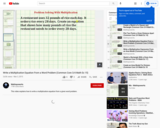
This video explains how to write a multiplication equation from a given word problem.
- Subject:
- Mathematics
- Material Type:
- Lesson
- Date Added:
- 04/20/2021

This video explains how to write a multiplication equation from a given word problem.
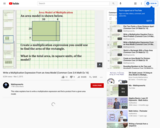
This video explains how to write a multiplication expression and find a product from a given area model.

In this lesson, students practice reading the poem "The Glass Frog" fluently (RF.3.4). Then they participate in a teacher-led Language Dive of the poem. This Language Dive guides students through the text's challenging vocabulary and language structures to help them understand the meaning of the poem (RL.3.1, RL.3.2, RL.3.4, RL.3.5, RF.3.4, L.3.1a, L.3.1h, L.3.3, L.3.4a).
Students will participate in a Language Dive that guides them through the meaning of a stanza from the poem "The Glass Frog." All students learn how to decipher the stanza and will use this knowledge in their further exploration of frog adaptations. Students will apply their understanding of the structure of this stanza when interpreting poetry during the mid-unit assessment in Lesson 7.
In Work Time B, students continue to analyze the narrative model "Why the Poison Dart Frog Is So Colorful." This text is used as a model throughout the drafting process, in addition to "Why the Frog Has a Long Tongue." "Why the Poison Dart Frog Is So Colorful" is an exemplar of narrative writing for students at the third-grade level.
In Work Time C, the teacher and students write the end of the class draft of a narrative text together, both contributing their thoughts and ideas to the process while the teacher acts as scribe (W.3.3a, W.3.4, W.3.5). Shared writing enables teachers to make the writing process concrete and visible to students. This allows students to focus exclusively on the thinking involved in writing, not the process.
Shared writing is also a powerful way to model and guide key skills and concepts related to the writing process (e.g., organizing, drafting, revision, mechanics, and conventions). Students gain competence and confidence in their writing skills as the teacher models and guides the thinking process writers go through. Consider modeling, revising, or editing the completed narrative "Why Do Polliwogs Wiggle?" based on students' identified areas for improvement.
The research reading students complete for homework helps to build both their vocabulary and knowledge pertaining to frogs and specifically frog adaptations. By participating in this volume of reading over a span of time, students will develop a wide base of knowledge about the world and the words that help describe and make sense of it.
Students practice their fluency in Work Times A, B, and C by following along and reading silently as the teacher reads "The Wood Frog" and "Why the Poison Dart Frog Is So Colorful" aloud, as well as choral reading.
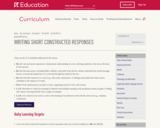
In Opening A, students receive their independent reading journals. This journal provides a space where students will begin responding to prompts concerning their independent reading book. Students will use these journals both throughout the module and the school year.
In Opening B, students receive an affix list to refer to throughout the rest of the year when determining the meaning of unfamiliar vocabulary (L.5.4b, L.5.4c). Consider laminating this resource for students, as it will be referred to frequently.
In Work Time A, students review the components of a sentence and participate in a mini lesson about writing short constructed responses. During this mini lesson, they write a short constructed response to answer a question about Rain School based on their close read in the previous lesson. This helps to prepare students for the End of Unit 1 assessment, in which they will answer short constructed response questions about a new text. After the mini lesson, students write short constructed responses to questions about their research reading text to serve as notes for their discussion for the Mid-Unit 1 Assessment in the next lesson (RI.3.1, W.3.1).
Lessons 3-5 featured built-out instruction for Goal 1 Conversation Cues. Moving forward, this will appear only as reminders after select questions. Continue using Goal 1 Conversation Cues to promote productive and equitable conversation. Refer to the Lesson 3 Teaching Notes and see the Tools page for additional information on Conversation Cues.
Students who finish quickly or require an extension can consider additional things they like and find challenging about their research reading texts.
In this unit, the habit of character focus is working to become an ethical person. Students continue to "collect" characteristics of ethical people on a Working to Become Ethical People anchor chart. The characteristic they collect in this lesson is integrity, based on the accountable independent reading homework they will complete each night.
The research reading that students complete for homework will help build both their vocabulary and knowledge pertaining to overcoming challenges in access to education, books, and reading near and far. By participating in this volume of reading over a span of time, students will develop a wide base of knowledge about the world and the words that help describe and make sense of it.
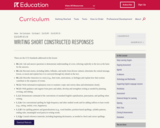
In this lesson, students write a short constructed response identifying the central message or lesson in Nasreen's Secret School and explaining how it is conveyed through details in the text (RL.3.2, W.3.2). This prepares them for the End of Unit 1 Assessment in the next lesson, in which they will answer short constructed response questions about a new text.
In Work Time B, students participate in a mini lesson on spelling, capitalization, and punctuation before participating in a peer review to check their peers' writing for proper spelling, capitalization, and punctuation (L.3.2e, L.3.2f, L.3.2g). This mini lesson does not go into detail; rather, the aim is to capture what students already know rather than to teach them anything new. The Spelling, Capitalization, and Punctuation handout is referred to both throughout this module and the school year. They then use this to peer-critique (W.3.5).
The peer critique that students participate in is the first of many. Consider any additional guidelines you would like to establish for this routine, as it will be returned to throughout the year. The Peer Critique anchor chart created in this lesson will be referred to both throughout the module and the school year.
Continue to reinforce the habits of character introduced throughout the unit, particularly as students may be sensitive to the content of this story, and also as they provide peer feedback.
Continue to use Goal 1 Conversation Cues to promote productive and equitable conversation.
The research reading that students complete for homework will help build both their vocabulary and knowledge pertaining to overcoming challenges in access to education, books, and reading near and far. By participating in this volume of reading over a span of time, students will develop a wide base of knowledge about the world and the words that help describe and make sense of it.
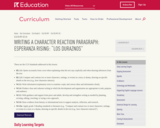
In this lesson, students independently write a paragraph about Esperanza's reaction to Miguel losing his job (RL.5.1, RL.5.3, W.5.2, W.5.4).
Students then participate in their first peer critique during Work Time B. Consider any additional guidelines to establish for this routine, as it will be returned to throughout the year. Following this peer critique, students revise their literary essays based on peer feedback (W.5.5). Peer feedback is focused on the criteria on the Character Reaction Paragraph anchor chart.
If time permits, consider allowing more time for peer review focused on common issues students may need more support with.
Because the content of "Los Duraznos" is centered around discrimination, students revisit Article 2 of the UDHR at the end of the lesson.
In this lesson, the habit of character focus is on working to become an ethical person. The characteristics that students are reminded of specifically are respect, empathy, and compassion as they critique one another's work and share stories/reflections about discrimination.
The research reading that students complete for homework will help build both their vocabulary and knowledge pertaining to human rights. By participating in this volume of reading over a span of time, students will develop a wide base of knowledge about the world and the words that help describe and make sense of it.

Students will complete a series of tasks to build skills in preparation of writing a descritpive/narrative essay.
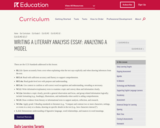
In this lesson, students analyze the structure of a model literary analysis about the author's use of concrete and sensory language in The Great Kapok Tree. This prepares them for writing their own literary analysis in which they analyze the concrete and sensory language in the excerpt from pages 41-42 of The Most Beautiful Roof in the World, read closely in Lesson 5 (W.5.2).
The literary analysis written during this half of the unit is done in pairs. This gives students a thought partner during the writing process. At the end of the unit, students will write a literary essay independently (W.5.2).
After analyzing the model essay, students work in pairs to choose a focus statement from a provided selection (W.5.2a) and to identify the concrete and sensory language they would like to use to develop the topic with quotes in their essay (W.5.2b).
Over the next several lessons, students use the Informative Writing Planning graphic organizer to plan their essays (W.5.2). Students may be familiar with this graphic organizer from fourth grade, as it follows the same overall format. However, while the format is the same, the focus question and content increases the rigor in fifth grade.
An example Informative Writing Planning graphic organizer is provided in the supporting materials; however, in this lesson students only complete the focus statement at the top of the graphic organizer. They will complete each part of the graphic organizer before drafting the corresponding paragraph over the next few lessons.
In Closing and Assessment, students practice reading aloud an excerpt from The Most Beautiful Roof in the World in preparation for the reading fluency assessment required as part of the End of Unit 2 Assessment (RF.5.4).
The research reading that students complete for homework helps build both their vocabulary and knowledge pertaining to the rainforest, specifically rainforest species and research. By participating in this volume of reading over time, students will develop a wide base of knowledge about the world and the words that help describe and make sense of it. Inviting students to share what they have been learning through independent reading holds them accountable.
In this lesson, the habit of character focus is working to become an effective learner. The characteristics students are reminded of specifically are collaboration and respect, as they work in pairs on their literary analysis essays and as they provide kind, specific, and helpful reading fluency feedback.
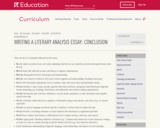
In this lesson, students analyze the conclusion of the Model Essay: Concrete and Sensory Language in The Great Kapok Tree to generate criteria for the conclusion of their own literary analysis essay to answer the question: "What does the use of concrete language and sensory detail help you understand about the rainforest?" Students then work in pairs to write the conclusion for their literary analysis essay (W.5.2c).
When students have finished writing their conclusion, they will work with a student other than their writing partner to proofread for spelling and punctuation errors. They will then work with their writing partner to revise the essay (L.5.1, L.5.2).
At the end of the lesson, students continue to practice reading aloud a new excerpt of The Most Beautiful Roof in the World in preparation for the reading fluency assessment required as part of the End of Unit 2 Assessment (RF.5.4).
The research reading that students complete for homework helps build both their vocabulary and knowledge pertaining to the rainforest, specifically rainforest species and research. By participating in this volume of reading over time, students will develop a wide base of knowledge about the world and the words that help describe and make sense of it. Inviting students to share what they have been learning through independent reading holds them accountable.
In this lesson, the habit of character focus is working to become an effective learner. The characteristics students are reminded of specifically are collaboration and respect, as they work in pairs on their literary analysis essays and provide kind, specific, and helpful reading fluency feedback.
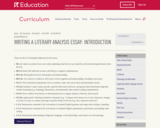
In this lesson, students begin by analyzing the introduction of the Model Essay: Concrete and Sensory Language in The Great Kapok Tree to generate criteria for the introduction to their own literary analysis essay to answer the question: "What does the use of concrete language and sensory detail help you understand about the rainforest?" Students then work in pairs to plan an introduction and write the introduction to their literary analysis essay as a class (W.5.2a).
It is important that students understand the purpose of writing a literary analysis. Ensure students understand that analyzing literature can help them to write stronger narratives, because when analyzing literature they are usually studying the craft and technique of the author, which they can then apply to their own work. Explain also that a literary analysis is a form of academic writing, something that they will continue to do in high school, and in college.
Although students plan their literary essay in pairs, each student writes his or her own essay.
At the end of the lesson, students practice reading aloud another excerpt from The Most Beautiful Roof in the World in preparation for the reading fluency assessment required as part of the End of Unit 2 Assessment (RF.5.4). Students use the Reading Fluency Checklist to self-assess their performance.
The research reading that students complete for homework helps build both their vocabulary and knowledge pertaining to the rainforest, specifically rainforest species and research. By participating in this volume of reading over time, students will develop a wide base of knowledge about the world and the words that help describe and make sense of it. Inviting students to share what they have been learning through independent reading holds them accountable.
In this lesson, the habits of character focus are working to become an effective learner and working to become an ethical person. The characteristics students are reminded of specifically are integrity, as they will be sharing their research reading homework, collaboration as they work in pairs on their literary analysis essays, and respect as they provide kind, specific, and helpful reading fluency feedback.
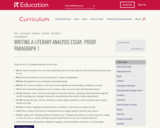
In this lesson, students analyze the first proof paragraph of the Model Essay: Concrete and Sensory Language in The Great Kapok Tree to generate criteria for the first proof paragraph of their own literary analysis essay to answer the question: "What does the use of concrete language and sensory detail help you understand about the rainforest?" Students then work in pairs to write the first proof paragraph for their literary analysis essay (W.5.2b, W.5.2c, W.5.2d).
At the end of the lesson, students continue to practice reading aloud a new excerpt of The Most Beautiful Roof in the World in preparation for the reading fluency assessment required as part of the End of Unit 2 Assessment (RF.5.4).
Students who finish quickly or require an extension can begin to plan their second proof paragraph.
The research reading that students complete for homework helps build both their vocabulary and knowledge pertaining to the rainforest, specifically rainforest species and research. By participating in this volume of reading over time, students will develop a wide base of knowledge about the world and the words that help describe and make sense of it. Inviting students to share what they have been learning through independent reading holds them accountable.
In this lesson, the habit of character focus is working to become an effective learner. The characteristics students are reminded of specifically are collaboration and respect, as they work in pairs on their literary analysis essays and as they provide kind, specific, and helpful reading fluency feedback.
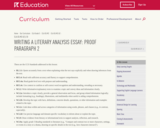
In this lesson, students write the second proof paragraph for their literary analysis essay, using the same proof paragraph criteria generated in Lesson 9 (W.5.2b, W.5.2d). Because the proof paragraph criteria were generated in the previous lesson, students have time in this lesson to review linking words to connect information (W.5.2c).
At the end of the lesson, students continue to practice reading aloud a new excerpt of The Most Beautiful Roof in the World in preparation for the reading fluency assessment required as part of the End of Unit 2 Assessment (RF.5.4).
Students who finish quickly or require an extension can exchange essays with another student to proofread for spelling and punctuation errors (L.5.1, L.5.2).
The research reading that students complete for homework helps build both their vocabulary and knowledge pertaining to the rainforest, specifically rainforest species and research. By participating in this volume of reading over time, students will develop a wide base of knowledge about the world and the words that help describe and make sense of it. Inviting students to share what they have been learning through independent reading holds them accountable.
In this lesson, the habit of character focus is working to become an effective learner. The characteristics students are reminded of specifically are collaboration and respect, as they work in pairs on their literary analysis essays and provide kind, specific, and helpful reading fluency feedback.
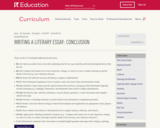
In this lesson, students plan and write the conclusion paragraph of their literary essays (RL.5.3, W.5.2a, W.5.2e, W.5.4, W.5.9a).
In the Closing, students are guided through a research reading share. Consider using the Independent Reading: Sample Plans if you do not have your own independent reading review routines. This review is designed to hold students accountable for their research reading completed for homework. This volume of reading promotes students' growing ability to read a variety of literary and informational texts independently and proficiently. (RI.5.10, RL.5.10, SL.5.1)
In this unit, the habit of character focus is on working to become an effective learner. The characteristic that students collect in this lesson is perseverance, because this is their first time writing a full essay this school year.
The research reading that students complete for homework will help build both their vocabulary and knowledge pertaining to human rights. By participating in this volume of reading over a span of time, students will develop a wide base of knowledge about the world and the words that help describe and make sense of it.
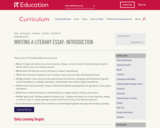
In this lesson, students plan and write the introductory paragraph for their literary essays (W.5.2a, W.5.4, W.5.9a).
Before writing their introductions, students participate in a mini lesson about producing complete sentences.
In this unit, the habit of character focus is on working to become an effective learner. The characteristic that students collect in this lesson is collaboration, because they will be working in pairs to write an essay about the event/situation they have chosen.
In the Closing, students practice reading their two-voice poems aloud to another pair. This is in preparation for reading monologues aloud in Unit 3 (RF.5.4).
The research reading that students complete for homework will help build both their vocabulary and knowledge pertaining to poetry and what inspires people to write. By participating in this volume of reading over a span of time, students will develop a wide base of knowledge about the world and the words that help describe and make sense of it.
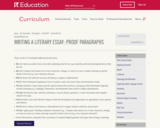
In this lesson, students write Proof Paragraphs 1 and 2 of their essays. This is written in pieces with students saying each part aloud before writing (RL.5.1, RL.5.3, W.5.2a, W.5.2b, W.5.4, W.5.9a).
Students have already written at least one, and possibly both, of the paragraphs either themselves or as a group write in the first half of unit lessons, and for homework. As a result, in this lesson, some students will only need to check their paragraphs against the criteria on the Literary Essay anchor chart and copy them onto their essay.
Students who require an extension can write their own new proof paragraphs rather than using the ones already written as a group in previous lessons.
In this unit, the habit of character focus is on working to become an effective learner. The characteristic that students collect in this lesson is perseverance, because this is their first time writing a full essay this school year. They also practice collaboration, as they continue to work in pairs to write their literary essay.
At the end of the lesson, students practice reading their two-voice poems aloud to another pair. This is in preparation for reading monologues aloud in Unit 3 (RF.5.4).
The research reading that students complete for homework will help build both their vocabulary and knowledge pertaining to human rights. By participating in this volume of reading over a span of time, students will develop a wide base of knowledge about the world and the words that help describe and make sense of it.
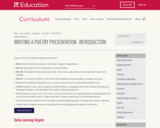
In this lesson, students consider the question "What inspired you to write poetry, and where can you see evidence of this in your poem?" as they begin to write their presentations for the performance task. They begin by analyzing the structure of a model presentation in triads, and then move on to focus on the introduction, generating criteria for an effective introduction before writing their own presentations (W.4.2a, W.4.2b, W.4.4, L.4.1f).
At the end of the lesson, students generate criteria for reading fluency on the Fluent Readers Do These Things anchor chart (RF.4.4).
In this lesson, the habit of character focus is on working to become an effective learner. The characteristic that students are reminded of specifically is collaboration, as they work in a triad to analyze the structure of the model.
The research reading that students complete for homework will help build both their vocabulary and knowledge pertaining to poetry and creative writing. By participating in this volume of reading over a span of time, students will develop a wide base of knowledge about the world and the words that help describe and make sense of it.
This lesson is the final in a series of three that include built-out instruction for the use of Goal 2 Conversation Cues to promote productive and equitable conversation (adapted from Michaels, Sarah and O'Connor, Cathy. Talk Science Primer. Cambridge, MA: TERC, 2012. Based on Chapin, S., O'Connor, C., and Anderson, N. [2009]. Classroom Discussions: Using Math Talk to Help Students Learn, Grades K-6. Second Edition. Sausalito, CA: Math Solutions Publications). Goal 2 Conversation Cues encourage students to listen carefully to one another and seek to understand. Continue drawing on Goal 1 Conversation Cues, introduced in Unit 1, Lesson 3, and add Goal 2 Conversation Cues to more strategically promote productive and equitable conversation. As the modules progress, Goal 3 and 4 Conversation Cues are also introduced. Consider providing students with a thinking journal or scrap paper.
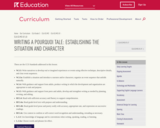
In this lesson, students write the beginning of their pourquoi tale (W.3.3, W.3.3a). They are reminded to use Vocabulary Logs and the domain-specific Word Wall to ensure their language is precise and interesting (L.3.3, L.3.3a).
In Work Time A, students begin using the Narrative Writing Checklist (W.3.3). Throughout the school year, students are provided with checklists for their writing, which outline the key criteria that the CCSS require of the writing type. These checklists are closely aligned with the teacher rubrics used to grade student assessments. An empty column is provided on each student checklist for students to add criteria for the specific characteristics required by the writing prompt, and time, directions, and examples for this process are built into the relevant lessons.
The focus standard in this half of the unit is W.3.3a, W.3.3b. W.3.3c, W.3.3d. Please be aware that the Narrative Writing Checklist also addresses many other skills and standards that are not taught in great detail in this half of the unit. Those skills and standards are present on the checklist because it is important for students to become familiar with what is required in an effective piece of narrative writing. It is important that they are made aware of these skills and practice them, even though they aren't the focus of this half of the unit.
In the interest of time, students revise and edit their pourquoi tale as they go. Those who require more writing time may not be able to thoroughly revise and edit their pourquoi tales, but this isn't an emphasis of this unit.
Students who finish quickly or require an extension can illustrate the beginning of their stories.
In this unit, the habit of character focus is working to contribute to a better world. The characteristic they are reminded of in this lesson is: use my strengths as they read their drafts aloud in small groups.
The research reading students complete for homework helps to build both their vocabulary and knowledge pertaining to frogs and specifically frog adaptations. By participating in this volume of reading over a span of time, students will develop a wide base of knowledge about the world and the words that help describe and make sense of it.
Students practice their fluency in this lesson by reading the beginning of their pourquoi tale aloud in Closing and Assessment A.
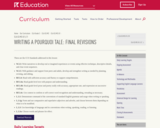
In this lesson, students revise their pourquoi tales with a specific focus on comparative and superlative adjectives and word choice (L.3.1g, L.3.3a). Although student work may or may not feature comparative and superlative adjectives, this is a time to learn and practice the rules associated with the use of these words.
Students also continue to practice reading their pourquoi tale aloud in preparation for the Frog Festival in the next lesson. They self-assess their performance against the Reading Fluency Self-Assessment Checklist to identify skills to work on before the Frog Festival. If using the Reading Fluency component of the Additional Language and Literacy block, students will already be familiar with this checklist, and so less time will need to be spent reading the criteria. Please note that students will be formally assessed on RF.3.4 during the festival.
The research reading students complete for homework helps to build both their vocabulary and knowledge pertaining to frogs and specifically frog adaptations. By participating in this volume of reading over a span of time, students will develop a wide base of knowledge about the world and the words that help describe and make sense of it.
Students practice their fluency in this lesson by reading their pourquoi tale aloud in Work Time C.
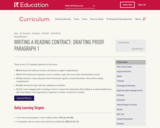
I can write proof paragraph 1 of my reading contract. (W.3.2a, W.3.2b)
I can fluently read an excerpt of text aloud for an audiobook. (RF.3.4, SL.3.5)
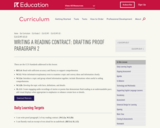
Purpose of lesson and alignment to standards:
In this lesson, students write proof paragraph 2 of their reading contracts. This is written in pieces with students saying each part aloud before writing. A template has also been provided for those students who may need it (W.3.2a, W.3.2b).
At the end of the lesson, students continue to practice reading their fluency excerpt. This time, they read in book groups. This is to provide students with practice reading in the same sequence they will read for the audio recording for the end of unit assessment. When listening to students, use common issues as teaching points in this lesson (RF.3.4, SL.3.5).
If there are not complete groups for reading fluency practice, invite students who feel comfortable doing so to take over the missing parts, but emphasize that they won't be assessed on the extra parts they are reading.
The research reading that students complete for homework will help build both their vocabulary and knowledge pertaining to overcoming challenges in access to education, books, and reading near and far. By participating in this volume of reading over a span of time, students will develop a wide base of knowledge about the world and the words that help describe and make sense of it.